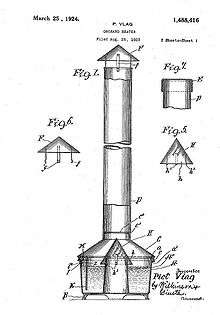Smudge pot

A smudge pot (also known as a choofa or orchard heater) is an oil-burning device used to prevent frost on fruit trees. Usually a smudge pot has a large round base with a chimney coming out of the middle of the base. The smudge pot is placed between trees in an orchard. The burning oil creates some heat, but more importantly, a large amount of smoke, particulates, carbon dioxide, and water vapor. This deliberate smog forms a "blanket" that blocks infrared light, thereby preventing radiative cooling that would otherwise cause or worsen frost.[1] (Low clouds can have a similar "infrared blanket" effect, which is why cloudy nights tend to be warmer than clear-sky nights.)
History
Smudge pots were developed after a disastrous freeze in Southern California in January 1913 wiped out a whole crop.[2]
Smudge pots were commonly used for seven decades in areas such as California's numerous citrus groves.
Smudge pot use in Redlands, California groves continued into the 1970s, but fell out of favor as oil prices rose and environmental concerns increased. Pots came in two major styles: a single stack above a fuel oil-filled base, and a slightly taller version that featured a cambered neck and a re-breather feed pipe out of the side of the chimney that siphoned stack gas back into the burn chamber and produced more complete combustion. Filler caps have a three- or four-hole flue control. The stem into the pot usually has a piece of oil-soaked wood secured inside the neck to aid in lighting the pot. Pots are ignited when the air temperature reaches 29 degrees Fahrenheit (-2 Celsius), and for each additional degree of drop, another hole is opened on the control cap. Below 25 degrees, nothing more can be done to enhance the heating effects.
Types and usage
Some groves used natural gas pots on lines from a gas source, but these are not "smudge pots" in the usual sense, and they represented only a fraction of the smudging practice. Sometimes, large smudge pots are used for heating large open buildings, such as mechanics' workshops. In Australia they are called "choofers" because of the noise they make when lit — "choofa choofa choofa".
Lighting an Australian "choofer" is a tricky business. Because of the voluminous clouds of oily black smoke they produce when cold, they must be lit outside. This is accomplished by holding a burning rag next to the open damper on the fuel tank. The draught caused by the breeze passing through the chimney will draw air through the open damper into the fuel tank, where the surface of the fuel inside will light and burn instantly. Once the choofer is sufficiently warm, the damper may be closed until a steady rate of burning is attained, when the characteristic "choofa choofa choofa" noise is produced. If the damper is not closed, the choofa may choke itself with its own smoke, causing periodic "explosions" of unburnt gases in the chimney. Such explosions are not dangerous, but they are noisy and they produce a lot of smoke. Once the heater is burning hot enough, the smoke will disappear and the pot may be dragged slowly and carefully inside. They still produce dangerous gas, and must only be used in well-ventilated spaces.
Choofers will burn almost any flammable liquid fuel, including kerosene, diesel fuel, or used sump oil.
Two other forms of oil heaters should be noted. Prior to the development of battery-powered safety blinkers on saw-horses, many highway departments used small oil-burning safety pot markers to denote work zones, and many railroad systems still rely on oil-fired switch heaters, long tubs of fuel with a wick, that fits between the ties and keeps snow and ice from fouling the points of a switch. This is generally only used in yard applications. Mainline switches are usually heated by natural gas heaters.
The smudge pot was also used at construction sites and other cold places to take the chill out of buildings so workers would be comfortable, and for several decades (1920's-1970's) they were used as emergency night landing illumination at remote airfields without electric runway lights, acting as a series of small bonfires.
Use in war
Smudge pots were used by the Germans during World War II and by the North Vietnamese in their invasions of Laos during the Vietnam War to protect valuable targets.[3] The oily black clouds of smoke produced from these smudge pots was intended to limit the ability to locate a target. In Vietnam, smoke from smudge pots was used as a defense against laser-guided bombs. Smoke would diffuse the laser beam and break the laser's connection with its intended target.[4]
Other significance
The smudge pot often became a symbolic prize in high school football rivalry.
- Bonita High School and San Dimas High School, affiliated with the Bonita Unified School District in Southern California, compete for a silver-plated smudge pot.
- In Redlands, California, Redlands High School and Redlands East Valley High School compete for a blue-and-red smudge pot.
References
- ↑ Marlo Martin (1989), "Chapter 4: Radiative cooling", in J. Cook, Passive Cooling, MIT Press, p. 140, ISBN 0-262-03147-7
- ↑ Moore, Frank Ensor (1995). "Redlands Astride the Freeway: The Development of Good Automobile Roads". Redlands, California: Moore Historical Foundation: 9. ISBN 0-914167-07-3.
- ↑ https://fas.org/man/dod-101/usaf/docs/halt.htm
- ↑ Tillford, Jr., Earl H. (April 2002). Setup: What the Air Force Did In Vietnam and Why. University Press of the Pacific. p. 246. ISBN 0-89875-839-4.